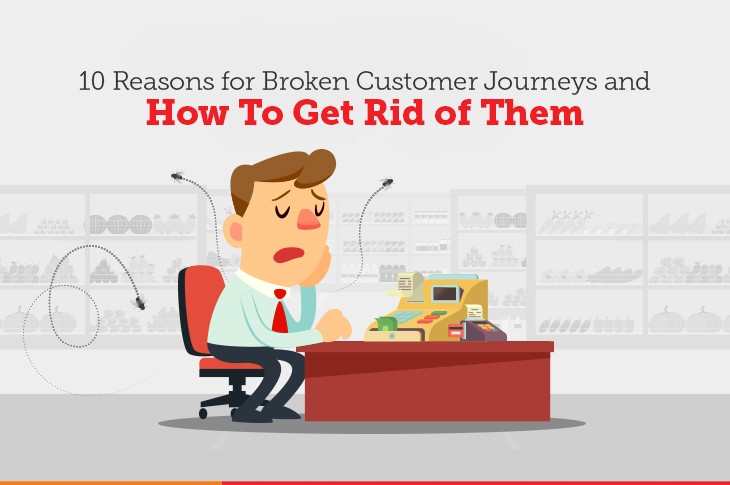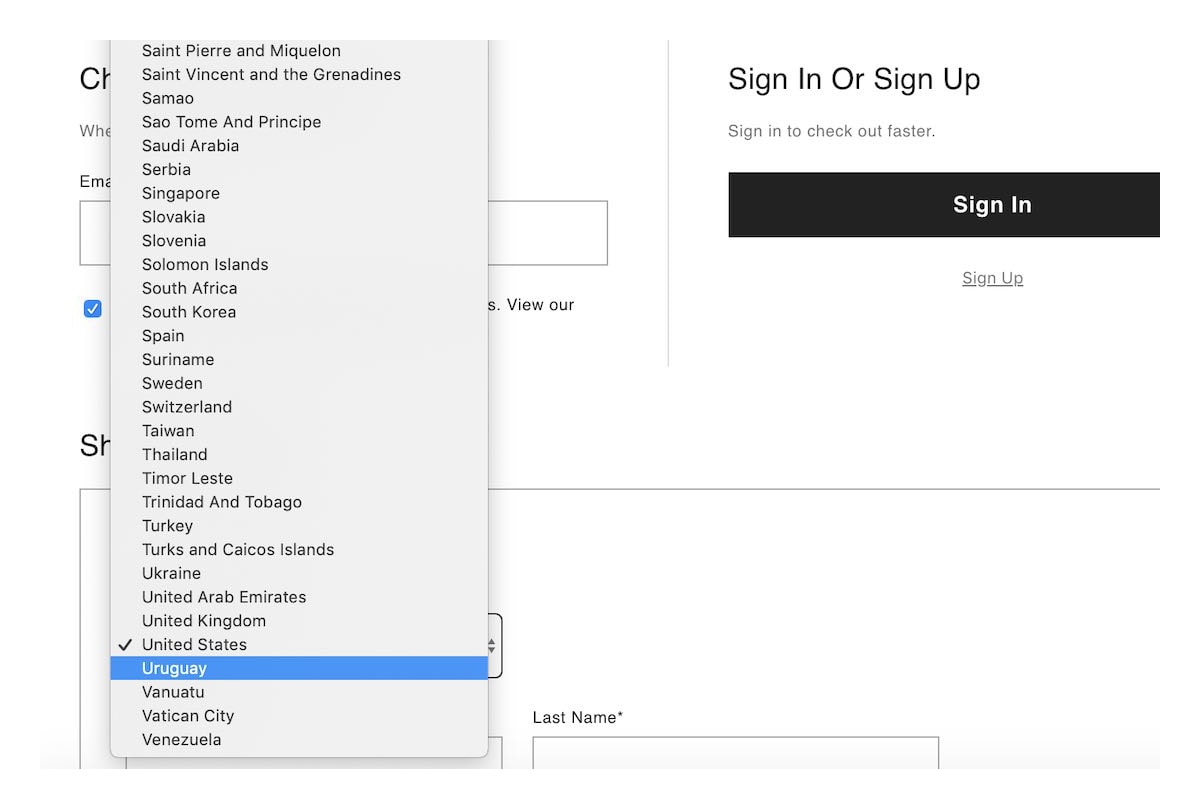10 Reasons for Broken Customer Journeys and How To Get Rid of Them

Customer journeys are no longer linear. With the proliferation of online business, multiple customer touchpoints have emerged. From websites to emails, and e-commerce platforms to social media channels, a prospective customer can get in touch with you anywhere, anytime. It is the seamless interconnection of these touchpoints that get a customer onto the purchase bandwagon.
Broken customer journeys transpire when companies fail to weave these touchpoints together, adversely affecting customer experience – and consequently their conversion. Here, we discuss ten such instances where a customer could not transit from one stage of the buyer journey to the next, and how this can be avoided.
1. When the customer lands on your web page from a misleading ad
Companies use outbound methods (such as pay-per-click ads or emails) or inbound methods (such as topical blogs) to initially draw customers to their website. To increase impressions, they may sometimes force-fit keywords in their marketing content that have nothing to do with what their business offers. So, when a customer lands on their website, they realize that they have been misled and bounce off immediately.
How to do this better?
Your content marketing strategy should focus on bidding for long-tail keywords – detailed search phrases that exactly match with what your product or service does. You must appear in the search results only when the potential customer does a refined search. So, when the customer lands on your website, they find just what they came for and are very, very likely to convert.
2. When the customer cannot find content to make up their mind
Let’s say a customer is looking to switch to healthier cooking options. While browsing the internet, they come across this really nice article published by a cookware brand that explains the benefits of air frying over deep frying. Impressed, the customer decides to check out the brand’s website to find out more about their products, especially air fryers. But all they get to read on the website are model numbers and prices. There is absolutely no mention of the warranty period, or which model will best suit the customer’s cooking preferences, family size, budget, etc. The customer leaves the website thinking they will probably have to visit a physical store to have these questions answered, delaying the customer conversion.
How to do this better?
Online beauty and wellness retailer Nykaa knows how to keep customers engaged throughout the buyer journey, making it India’s largest omnichannel beauty destination. Nykaa has a wealth of content in the form of blogs, guides, and videos on beauty advice, tips-and-tricks, makeup masterclasses, etc. to make informed choices. And when a customer searches for a particular product, they get a complete lowdown on it: price, description, instructions for use, ingredients, customer reviews, similar products, and even the expected delivery date – all in one place!

3. When the customer feels lost on your website or app
If your website or business app does not follow an intuitive navigation path, the customer will struggle to find what they are looking for – be it a product or information. The result? Broken customer journeys! The way your website or app is designed, written for, themed, and laid out, together decide how familiar and comfortable your visitors feel on it. The more comfortable they are, the more time they will spend exploring your website or app, and the more likely they are to buy something from you.
How to do this better?
An example of poor user experience is super-long dropdowns without search functionality. They are bad for two reasons: (a) It takes forever for the customer to find the right item, and (b) They hide the other fields or information in their vicinity when expanded. To build a UX-rich website or app, think like the potential customer – iterate your design and test, and use heat maps to uncover visitor eye tracking patterns.

4. When the customer cannot avail of a product demo before deciding to buy
When customers buy products online such as home appliances, software, or automobiles (typically anything with several working parts), they prefer to see a product demo before making the final decision. When your website does not have a demo, or if your demo is not satisfactory, the customer might lose interest in your product.
How to do this better?
Salesforce does demos quite well. The company takes you through real-life use cases that show where its products fit in, and how. It also demonstrates how different designations in a business will benefit from its products’ features. Go here to check out the company’s online demo for its product, Sales Cloud.
5. When the customer is unable to check out seamlessly
Studies show that around 70% of customers abandon their cart during an unsuccessful checkout. There could be several reasons for this, such as long page load times, hidden charges (taxes, delivery fee, etc.) that show up only at the time of checking out, mandatory account creation to complete the checkout, absence of preferred payment options, and so on. Inability to check out can be extremely frustrating for customers, and even if you have an unrivaled product catalog, your customers are going to end things with you.
How to do this better?
Nike is one brand that has an easy and precise checkout flow, and it’s limited to just three steps. It allows ‘guest checkout,’ which means customers do not have to create an account to finish their purchase. Well-articulated CTAs and prominent trust badges make for an easily navigable, secure checkout process.

6. When the customer gets no after-sales support
Most companies bask in the glory of a closed deal and forget that customers may require guidance on how to use the purchased product. For example, if a customer purchases software, they need installation guides and user manuals. The absence of such post-sales collateral adversely affects customer onboarding and can lead to high customer churn.
How to do this better?
An example of how customer onboarding is done right can be seen with Slack, which gives customers an interactive product walk-through after they sign up with them. Showing customers what to do and how to do it allows them to not only enjoy the product better but also trust your brand and stay loyal.

7. When the customer struggles between a business’ online and offline modes
It is quite likely today that a customer may place an order online and choose cash-on-delivery, or visit a physical store and redeem points gathered from past online purchases, or return products purchased online in-person. The inability to connect these customer touchpoints hampers customer experience and makes a brand look obsolete and conservative.
How to do this better?
Take Starbucks’ reward system, for instance. A Starbucks customer can recharge their card through the Starbucks app, website, or at an outlet. The points earned for ordering food or beverage at both places (physical stores as well as online) get automatically updated on the card and can also be redeemed across channels.

8. When the customer never hears back from you after buying once
If a brand goes incommunicado after securing a customer, it loses the opportunity for repeat business, or upsell/cross-sell. A customer is approached by dozens of brands daily. And just because they bought from you once does not in any way guarantee they will come back to you again. Sending personalized emails, WhatsApp or text messages with deals and discount codes, updates, season’s greetings, and other helpful content keeps your relationship alive and thriving.
How to do this better?
Think of Swiggy and Zomato. These food delivery giants regularly send personalized, engaging, and contextualized mailers that are both fun to read and informative. Here’s an example:

9. When the customer depends on you for every trivial issue
If your customers must email or call your support team whenever an issue, however minor, arises, they won’t stay with you for long. Identify common problems and questions that customers can self-service and create FAQs with step-by-step instructions on how to resolve them. You could then direct them to contact your customer support team for more complicated issues.
How to do this better?
Zappos has created an exhaustive, logically flowing set of FAQs that save visitors a lot of time.

10. When the customer is constantly put on hold
Let’s imagine a customer has some questions regarding their monthly invoice for a service. They call the toll-free number given on the company website, which by default goes to a tech-support person. This person then connects the customer with their colleague in the invoice department, who then connects the customer to their supervisor, who gives assurance for further investigation into the grievance and ends the call. Playing pass-the-parcel with your customer will have them looking for the exit door.
How to do this better?
The most effective way to provide quick, efficient customer service is by having all the information on each of your customers, up until their latest grievance, stored in an online repository that any agent can access. This way, when a customer calls an agent, the agent can easily pull up the customer’s profile. Armed with all the background information, the agent can either solve the issue themselves or immediately connect them with the right person.
Contributors to this blog post – Aastha Singh, Swapnil Adsul
